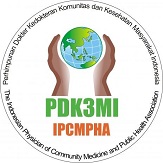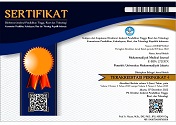A Descriptive Study about Students’ Symptoms and Knowledge of Computer Vision Syndrome
DOI:
https://doi.org/10.24853/mmj.2.2.41-48Keywords:
computer vision syndrome, knowledge, studentsAbstract
Background: The COVID-19 pandemic has had many impacts on various aspects of life, one of which is education. The education system has changed from face-to-face to online learning methods. Online learning methods make students more likely to use digital media such as computers, laptops or mobile phones. The use of digital media that occurs continuously and without being balanced with sufficient knowledge can certainly have impacts on eye health. One form of eye health problems that often arise due to the use of digital media is computer vision syndrome (CVS). Purposes: Therefore, it is necessary to conduct a study to see the picture of students' knowledge about this disorder. Methods: The method used in this research is cross-sectional descriptive. Result: The mean age of the respondents was 19.91±1.648 years. A total of 82.7% of respondents complained of having more than 5 symptoms and as many as 98.5% had CVS. 90.6% of respondents complained about fatigue eyes, followed by 80.5% complained about eye strain symptoms and 80.5% complained about headaches, 42.9% of respondents have a lack of knowledge about CVS and only 15.4% of respondents have a good level of knowledge about CVS. Conclusion: It can be concluded that respondents’ lack of knowledge about CVS is the cause of the high prevalence of CVS in students, so they don’t know how to prevent this CVS. Therefore, it is necessary to take actions to increase students' knowledge about this disorder, so that it doesn’t cause negative impacts on eye health in the future.References
World Health Organization. Coronavirus (COVID-19) events as they happen [Internet]. 2020 [cited 2020 May 19]. Available from: https://www.who.int/emergencies/diseases/novel-coronavirus-2019/even ts-as-they-happen
Arifudin O. Pandemi corona dan dampak terhadap dunia pendidikan. Pasundan Ekspres [Internet]. 2020 Mar17. Available from:https://www. pasundanekspres.co/opini/pandemi-corona-dan-dampak-terhadap-dunia-pendidikan/
Gowrisankaran S, Sheedy JE. Computer vision syndrome: A review. Work. 2015 Aug;52(2):303–14.Available from: http://www.ncbi. nlm.nih.gov/pubmed/26519133
Mowatt L, Gordon C, Santosh ABR, Jones T. Computer vision syndrome and ergonomic practices among undergraduate university students. Int J Clin Pract. 2018 Jan 1;72(1). Available from: https://onlinelibrary .wiley.com/doi/10.1111/ijcp.13035
Direktorat P2PTM Kemenkes RI. Apa itu CVS (Computer Vision Syndrome)? [Internet]. 2019 [cited 2020 Jul 7]. Available from: http://www.p2ptm.kemkes.go.id/infographic-p2ptm/stress/page/6/apa-i tu-cvs-computer-vision-syndrome
Cheema MN, Anwar S, Naz MA, Saleem A, Nawaz MM. Prevalence of computer vision syndrome and its risk factors among medical students of Islam Medical & Dental College, Sialkot. Pakistan J Med Heal Sci. 2019;13(3):553–5. Available from: https://www.pjmhsonline.com/2019/july_sep/pdf/553.pdf
Kumar BS. A study to evaluate the knowledge regarding computer vision syndrome among medical students. Biomed Pharmacol J. 2020;13(1):469–73. Available from: https://biomedpharmajournal.org/vol13no1/a-study-to-evaluate-the-kno wledge-regarding-computer-vision-syndrome-among-medical-students/
Ranasinghe P, Wathurapatha WS, Perera YS, Lamabadusuriya DA, Kulatunga S, Jayawardana N, et al. Computer vision syndrome among computer office workers in a developing country: An evaluation of prevalence and risk factors. BMC Res Notes. 2016 Dec 9;9(1):150. Available from: http://www.biomed central.com/1756-0500/9/150
Altalhi AA, Khayyat W, Khojah O, Alsalmi M, Almarzouki H. Computer vision syndrome among health sciences students in Saudi Arabia: Prevalence and Risk Factors. Cureus. 2020 Feb 20; 12(2):e7060. Available from: https://www.cureus. com/articles/26595-computer-vision -syndrome-among-health-science s-students-in-saudi-arabia-prevalence-and-risk-factors
Sen A, Richardson S. A study of computer-related upper limb discom fort and computer vision syndrome. J Hum Ergol (Tokyo). 2007;36 (2):45–50. Available from: https:// pubmed.ncbi.nlm.nih.gov/18572794/
Ranganatha SC, Jailkhani S. Pre-valence and associated risk factor of computer vision syndrome among the computer science students of an Engineering College of Bengaluru-A cross-sectional study. Galore Int J Heal Sci Res. 2019;4(3):10–5. Available from: https://www.gijhsr. com/GIJHSR_Vol.4_Issue.3_July2019/3.pdf
American Optometric Assosiation. Computer Vision Syndrome. [cited 2020 Jul 6]; Available from: https://www.aoa.org/patients-and-public/caring-for-your-vision/protec ting-your-vision/computer-visi on-syndrome
Agarwal S, Goel D, Sharma A. Evaluation of the factors which contribute to the ocular complaints in computer users. J Clin Diagn Res. 2013 Feb 1;7(2):331–5. Available from: https://pubmed.ncbi.nlm.nih .gov/23543722/
Logaraj M, Madhupriya V, Hegde SK. Computer vision syndrome and associated factors among medical and engineering students in Chennai. Ann Med Health Sci Res. 2014; 4(2):179-85. Available from: https:// pubmed.ncbi.nlm.nih.gov/24761234/
Wawan A, Dewi M. Teori & pengukuran pengetahuan, sikap, dan perilaku manusia. Yogyakarta: Nuha Medika; 2014.
Akinbinu TR, Mashalla YJ. Knowledge of computer vision syndrome among computer users in the workplace in Abuja, Nigeria. J Physiol Pathophysiol. 2013 Sep;4(4) :58–63. Available from: https://aca demicjournals.org/journal/JPAP/article-full-text-pdf/497CABC15892
Reddy SC, Low C, Lim Y, Low L, Mardina F, Nursaleha M. Computer vision syndrome: A study of knowledge and practices in university students. Nepal J Ophthalmol. 2013 Sep 23;5(2):161–8. Available from: https://www. nepjol.info/index.php/NEPJOPH/article/view/8707
Abudawood GA, Ashi HM, Almarzouki NK. Computer vision syndrome among undergraduate medical students in King Abdulaziz University, Jeddah, Saudi Arabia. J Ophthalmol. 2020 Apr 1;2020:1–7. Available from: https://www.hin dawi.com/journals/joph/2020/2789376/
Loh KY, Reddy SC. Understanding and preventing computer vision syndrome. Malaysian Fam Phy sician. 2008 Dec 31;3(3):128-30. Available from: https://www.e-mfp.org/old/2008v3n3/computer_vision_syndrome.html
Al Tawil L, Aldokhayel S, Zeitouni L, Qadoumi T, Hussein S, Ahamed SS. Prevalence of self-reported computer vision syndrome symp-toms and its associated factors among university students. Eur J Ophthalmol. 2020 Jan 1;30(1):189–95. Available from: https://journals. sagepub.com/doi/pdf/10.1177/1120672118815110
Iqbal M, El-Massry A, Elagouz M, Elzembely H. Computer vision syndrome survey among the medical students in Sohag University Hos pital, Egypt. Ophthalmol Res An Int J. 2018;8(1):1–8. Available from: https://www.journalor.com/index.php/OR/article/view/22479
Kharel Sitaula R, Khatri A. Knowledge, attitudes and practice of Computer Vision Syndrome among medical students and its impact on ocular morbidity. J Nepal Health Res Counc. 2018 Nov;16(3):291–6. Available from: https://www.nepjol .info/index.php/JNHRC/article/view/21426
Samhitha J, Jilta J, Ramya K, Indira S. Knowledge on computer vision syndrome. Int J Appl Res [Internet]. 2017;3(12):434–7. Available from: https://www.allresearchjournal.com/archives/2017/vol3issue12/PartG/3-12-71-645.pdf
Mersha GA, Hussen MS, Belete GT, Tegene MT. Knowledge about computer vision syndrome among bank workers in Gondar City, Northwest Ethiopia. Occup Ther Int. 2020 Apr;2020:1–5. Available from: https://www.hindawi.com/journals/oti/2020/2561703/
Amirul FZ, Aqilah R, Lee ML, Azuhairi AA, Isa MM. Knowledge, attitude and practice of computer vision syndrome among staffs that use video display terminal in a faculty of a Malaysian Public University. Int J Public Heal Clin Sci. 2015;2(1):137–47. Available from: http://publichealthmy.org/e journal/ojs2/index.php/ijphcs/article/view/162
Downloads
Published
Issue
Section
License
Authors who publish in the Muhammadiyah Medical Journal agree to the following terms:
- Authors retain copyright and grant Muhammadiyah Medical Journal right of first publication with the work simultaneously licensed under a Creative Commons Attribution Licence that allows others to adapt (remix, transform, and build) upon the work non-commercially with an acknowledgement of the work's authorship and initial publication in Muhammadiyah Medical Journal.
- Authors are permitted to share (copy and redistribute) the journal's published version of the work non-commercially (e.g., post it to an institutional repository or publish it in a book), with an acknowledgement of its initial publication in Muhammadiyah Medical Journal.








